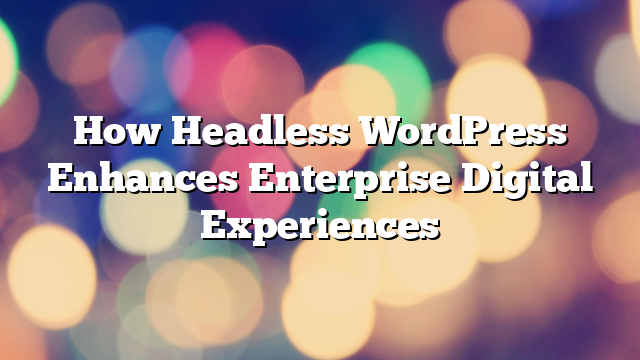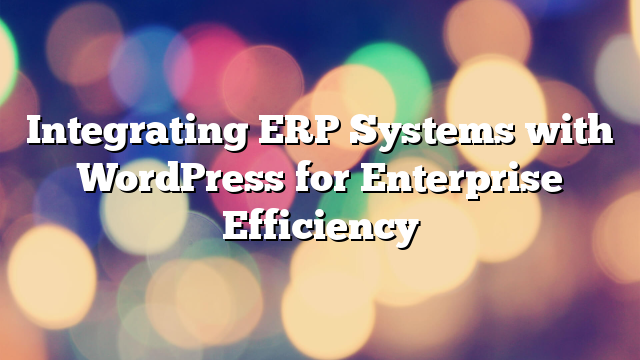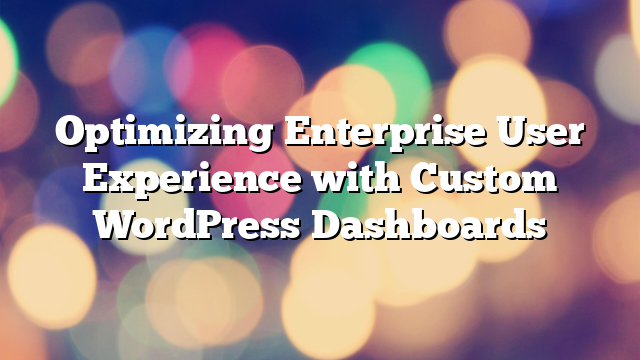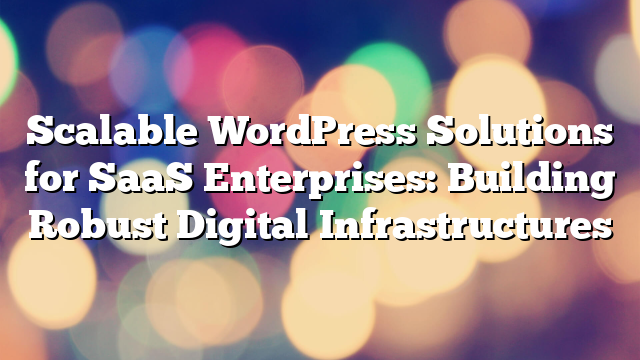How Headless WordPress Enhances Enterprise Digital Experiences
04.01.2025

As enterprises strive to deliver exceptional digital experiences, traditional WordPress architectures sometimes fall short in addressing modern demands. Enter Headless WordPress—a flexible, API-driven approach that decouples the back end from the front end. By leveraging this architecture, enterprises can achieve faster performance, enhanced scalability, and seamless integrations across multiple platforms. In this article, we’ll explore how Headless WordPress is revolutionizing enterprise digital experiences.
What is Headless WordPress?
Headless WordPress separates the WordPress content management system (CMS) from its front-end presentation layer. The back end handles content creation and storage, while APIs (such as REST or GraphQL) deliver content to any front-end framework, such as React, Next.js, or Vue.js.
This decoupled approach empowers enterprises to deliver content across websites, mobile apps, and other digital touchpoints efficiently, without being constrained by traditional WordPress themes.
Key Benefits of Headless WordPress for Enterprises
1. Superior Performance
Headless WordPress allows enterprises to build lightweight front ends optimized for speed. By reducing dependency on traditional WordPress themes and PHP-based rendering, websites can achieve faster loading times and improved user experiences.
2. Omnichannel Content Delivery
Enterprises often need to deliver content across various channels, including websites, mobile apps, kiosks, and IoT devices. Headless WordPress enables seamless content distribution through APIs, ensuring consistency and efficiency across all platforms.
3. Enhanced Scalability
Decoupling the front end from the back end allows enterprises to scale each layer independently. For example, the front end can be optimized to handle high traffic volumes without affecting the back-end performance.
4. Flexibility in Front-End Development
With Headless WordPress, developers can use modern frameworks like React, Angular, or Vue.js to create dynamic and engaging user interfaces. This freedom fosters innovation and ensures the front end remains future-proof.
5. Improved Security
By separating the CMS from the front end, Headless WordPress reduces potential attack vectors. APIs can be configured with authentication protocols, adding an extra layer of security to enterprise websites.
Use Cases of Headless WordPress in Enterprises
1. Global Content Management
Enterprises with global operations often require a centralized CMS that delivers localized content to various regions. Headless WordPress allows for tailored content delivery across multiple platforms while maintaining centralized control.
2. Progressive Web Apps (PWAs)
Progressive Web Apps offer fast, app-like experiences on the web. Headless WordPress provides the content infrastructure needed to power PWAs, ensuring seamless integration with advanced front-end frameworks.
3. Multi-Platform Publishing
For enterprises managing multiple digital touchpoints, such as websites, apps, and social media platforms, Headless WordPress serves as a unified content hub. This ensures content consistency and streamlines publishing workflows.
4. E-Commerce Solutions
Headless WordPress can be integrated with e-commerce platforms like WooCommerce or Shopify, enabling enterprises to deliver fast, personalized shopping experiences across devices.
Challenges of Adopting Headless WordPress
1. Increased Complexity
Headless architecture introduces additional layers of complexity, requiring expertise in both back-end and front-end technologies. Enterprises must invest in skilled developers to manage this architecture effectively.
2. Higher Initial Costs
While Headless WordPress offers long-term benefits, the initial setup and development costs can be higher than traditional WordPress. However, the investment often pays off through improved performance and scalability.
3. Dependency on APIs
Headless WordPress relies heavily on APIs for content delivery. Poorly optimized APIs can lead to performance bottlenecks and complicate debugging processes.
Best Practices for Implementing Headless WordPress
1. Choose the Right Front-End Framework
Select a front-end framework that aligns with your enterprise’s goals and developer expertise. Popular choices include Next.js for server-side rendering and React for dynamic user interfaces.
2. Optimize APIs
Ensure your APIs are well-structured, fast, and secure. Use caching mechanisms and tools like GraphQL to improve query performance and reduce response times.
3. Prioritize Security
Implement strong authentication and encryption protocols for APIs. Regularly monitor API activity to detect and address potential vulnerabilities.
4. Plan for Scalability
Design your architecture to handle future growth. Use cloud-based hosting solutions and CDNs to distribute content efficiently across global audiences.
5. Test Thoroughly
Rigorous testing is essential to ensure seamless integration between the CMS and front-end. Test your APIs, content workflows, and user interfaces to identify and resolve issues early.
Conclusion
Headless WordPress empowers enterprises to deliver fast, scalable, and innovative digital experiences. By decoupling the back end from the front end, businesses can unlock new possibilities for content delivery, user engagement, and omnichannel publishing. If you’re ready to elevate your digital strategy, contact AllWebDev to explore how Headless WordPress can transform your enterprise’s online presence.



